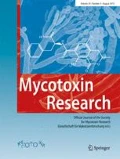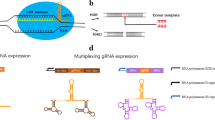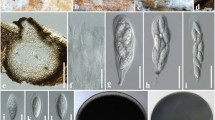Abstract
Sex in fungi is regulated by highly dissimilar mating type loci named idiomorphs. The genus Fusarium harbours both sexual as well as esexual species and each appears to contain one or the other idiomorph. The structure of these loci is highly conserved, suggesting a cryptic sexual cycle in these socalled asexual species. Alternatively, idiomorphs could regulate additional hitherto unrecognized biological processes. Such processes could be elucidated by expression profiling using mutants disrupted in their mating type loci.
Similar content being viewed by others
References
Arie T, Christiansen SK, Yoder OC, Turgeon BG (1997) Efficient cloning of ascomycete mating type genes by PCR amplification of the conserved MAT HMG box. Fungal Genet Biol 21: 118–130
Arie T, Kaneko I, Yoshida T, Noguchi M, Nomura Y, Yamaguchi I (2000) Mating-type genes from asexual phytopathogenic ascomycetesFusarium oxysporum andAlternaria alternata. Mol Plant-Microbe Interact 13: 1330–1339
Berbee ML, Payne BP, Zhang G, Roberts RG, Turgeon BG (2003) Shared ITS DNA substitutions in isolates of opposite mating type reveal a recombining history for three presumed asexual species in the filamentous asomycete genusAlternaria. Mycol Res 107: 169–182
Bobrowicz P, Pawlak R, Correa A, Bel-Pedersen D, Ebbole DJ (2002) TheNeurospora crassa pheromone precursor genes are regulated by the mating type locus and the circadian clock. Mol Microbiol 45: 795–804
Brown DW, Cheung F, Proctor RH, Butchko RAE, Zheng L, Lee Y, Utterback T, Smith TS, Feldblyum T, Glenn AE, Plattner RD, Kendra DF, Town CD, Whitelaw CA (2005) Comparative analysis of 87,000 expressed sequence tags from the fumonisin-producing fungusFusarium verticillioides. Fungal Genet Biol 42: 848–861
Dyer PS, Paoletti M, Archer DB (2003) Genomics reveals sexuals secrets ofAspergillus. Microbiology 149, 2301–2303
Goodwin SB, Waalwijk C, Kema GHJ, Cavaletto JR, Zhang G (2003) Cloning and analysis of the mating-type idiomorphs from the barley pathogenSeptoria passerinii. Mol Gen Genom 269: 1–12
Hull CM, Johnson AD (1999) Identification of a mating type-like locus in the asexual pathogenic yeastCandida albicans. Science 285: 1271–1275
Hull CM, Raisner RM, Johnson AD (2000) Evidence for mating of the “asexual” yeastCandida albicans in a mammalian host. Science 289: 307–310
Kerényi Z, Moretti A, Waalwijk C, Oláh B, Hornok L (2004) Mating type sequences in asexually reproducing Fusarium species. Appl Environm Microbiol 70: 4419–4423
Kenényi Z, Mulé G, Moretti A, Waalwijk C, Hornok L (2002) Fertility and mating type assessment withinFusarium proliferatum isolates from different host plants. J Appl Genet 43A: 55–68
Kerényi Z, Zeller K, Hornok L, Leslie JF (1999) Molecular standardization of mating type terminology in theGibberella fujikuroi species complex. Appl Environ Microb 65: 4071–4076
Magee BB, Magee PT (2000) Induction of mating in Candida albicans by construction of MTLa and MTLα strains. Science 289: 310–313
Marra RE, Milgroom MG (1999) PCR amplification of the mating-type idiomorphs inCryphonectria parasitica. Molec Ecol 8: 1947–1950
Metzenberg RL, Glass NL (1990) Mating type and mating strategies inNeurospora. BioEssays 12: 53–59
O'Donnell K, Sutton DA, Rinaldi MG, Magnon KC, Cox PA, Revankar SG, Sanche S, Geiser DM, Juba JH, van Burik JAH, Padhye A, Anaissie EJ, Francesconi A, Walsh TJ, Robinson JS (2004) Genetic diversity of human pathogenic members of theFusarium oxy-sporum complex inferred from multilocus DNA sequence data and amplified fragment length polymorphism analyses: Evidence for the recent dispersion of a geographically widespread clonal lineage and nosocomial origin. J Clin Microbiol 42: 5109–5120
Paoletti M, Rydholm C, Schwier EU, Anderson MJ, Szakacs G, Lutzoni F, Debeaupuis JP, Latgé JP, Denning DW, Dyer PS (2005) Evidence for Sexuality in the Opportunistic Fungal PathogenAspergillus fumigatus. Curr Biol 15, 1242–1248
Sharon A, Yamaguchi K, Christiansen SK, Horwitz BA, Yoder OC, Turgeon BG (1996). An asexual fungus has the potential for sexual development. Mol Gen Genet 251: 60–68
Tatusova TA, Madden TL (1999) Blast 2 sequences — a new tool for comparing protein and nucleotide sequences. FEMS Microbiol Lett 174: 247–250
Turgeon BG, Yoder OC (2000) Proposed nomenclature for mating type genes of filamentous ascomycetes. Fungal Genet Biol 31: 1–5
Waalwijk C, Mendes O, Verstappen ECP, de Waard MA, Kema GHJ (2002) Isolation and characterization of the mating-type idiomorphs from the wheat septoria leaf blotch fungusMycosphaerella graminicola. Fungal Genet Biol 35: 277–286
Waalwijk C, van der Lee TAJ, de Vries PM, Hesselink T, Arts J, Kema GHJ (2004) Synteny in toxigenicFusarium species: the fumonisin gene cluster and the mating type region as examples. Eur J Pl Pathol 110: 533–544
Yun SH, Arie T, Kaneko I, Yoder OC, Turgeon BG (2000) Molecular organization of mating type loci in heterothallic, homothallic, and asexualGibberella/Fusarium species. Fungal Genet Biol 31: 7–20
Author information
Authors and Affiliations
Corresponding author
Additional information
Financial support: Fifth Framework Program of the EU (QUK-CT 1999-001380). De Fox-Fungi) grant from the collaboration between NWO (048.011 044) and OTKA (1 43221)
Rights and permissions
About this article
Cite this article
Waalwijk, C., Keszthelyi, A., van der Lee, T. et al. Mating type loci inFusarium: structure and function. Mycotox Res 22, 54–60 (2006). https://doi.org/10.1007/BF02954558
Issue Date:
DOI: https://doi.org/10.1007/BF02954558




